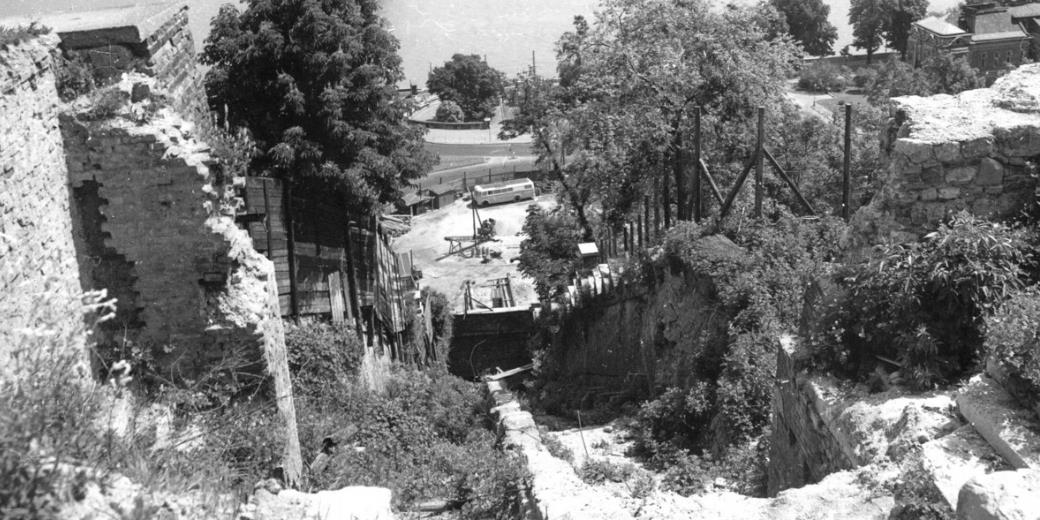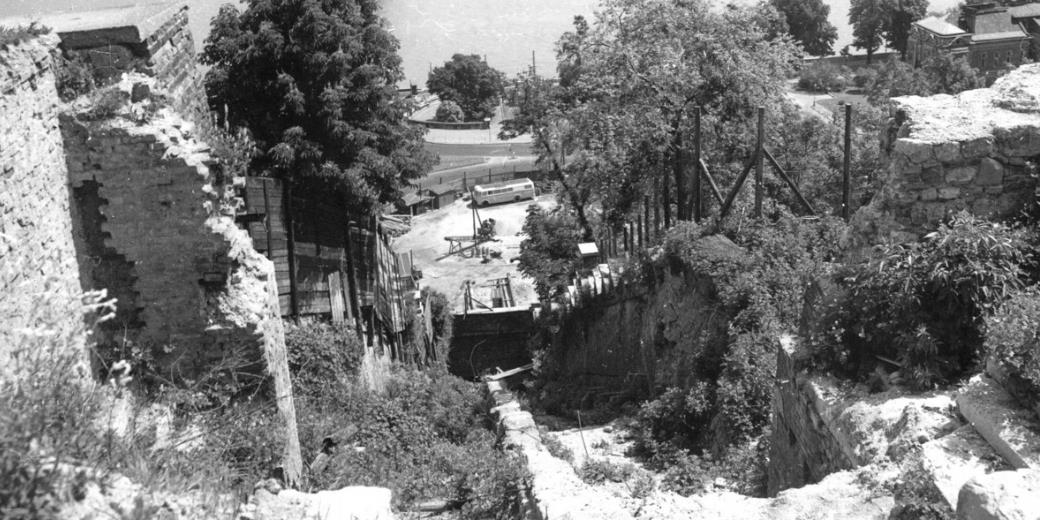Budavári Sikló
Története
A Budavári Siklót, eredeti nevén a Budai Hegypályát 1870. március 2-án vehette birtokba az utazóközönség.
A világ második siklója gróf Széchenyi Ödön, gróf Széchenyi István fiának kezdeményezésére épült meg.

Széchenyi a Lyonban látott példa nyomán tett javaslatot egy gőzhajtású, kötélvontatású vasút megépítésére. Az új közlekedési eszköz fő célja a Várban működő minisztériumok és a Várszínház gyorsabb, egyszerűbb megközelítésének elősegítése volt, ugyanis ekkoriban (egészen 1928-ig, az első Várba közlekedő buszjárat elindulásáig) ezeket más tömegközlekedési eszközzel nem lehetett elérni.
Kiépítésének helyét a korabeli forgalmi viszonyok alapján határozták meg. Széchenyi 1868 májusában kapta meg az engedélyt a hegypálya megépítésére, júliusban pedig már a kivitelezést is megkezdték. A sikló létesítményeinek terveit Jaruszek Ödön készítette. A munkálatokat Jaruszek, majd - az építési terveket is átalakító - Wolfahrt Henrik irányította.
A pálya alsó végére egy nagyobb méretű, impozáns indítócsarnokot építettek, ahol a gépészeti berendezések is helyet kaptak; a felső állomáson egy egyszerűbb kivitelű fogadóépületet emeltek. A mozgatóerőt az alsó állomáson elhelyezett gőzgép biztosította. A normál nyomtávú, 30 fokos hajlásszögű pálya hossza 95 méter és 50 méteres szintemelkedést kellett leküzdenie.

A pálya mellett a kocsik műszaki megoldásai is egyedülállóak voltak. A bécsi Anton Spiering Maschinen- und Wagenbau-Fabrik üzemben készült járművek három lépcsőzetesen egymás fölé helyezett fülkéből álltak, a középső 6 fő, a szélsők 8 fő szállítására voltak alkalmasak. A pályán egyszerre két ingajelleggel összekötött kocsi közlekedett, az egyik felfelé, a másik lefelé. Különleges megoldás volt biztonsági berendezésük is: a kocsik alján található vaskarmok a pálya mentén elhelyezett gerendákba akadva képesek voltak megállítani az elszabadult járművet.
Üzemeltetését a Budai Hegypálya Rt. végezte, majd 1920-ban a főváros tulajdonában került.
Története során számos átalakítást végeztek rajta, de lényegében 1944 végéig változatlan műszaki megoldásokkal működött.
Budaostroma alatt 1944. december 20-án a siklót bombatalálat érte.

A háború után a helyreállítása helyett elbontása mellettdöntöttek, ugyanis a Várnegyed közlekedését autóbuszokkal kívánták megoldani. Bár esetleges helyreállítása igazából soha nem került le a napirendről, arra egészen 1986-ig várni kellett. Számos kezdeményezés után 1984 februárjában határozták el ténylegesen, hogy újjáépítik a siklót, a főváros és a BKV összefogásával a munkálatok 1984. április 10-én kezdődtek el.
A felújítás során a műszaki megoldások tekintetében a kor követelményeinek kellett megfelelni, de az állomások és a kocsik a múltat kívánták megidézni. A megújult sikló villanymotoros meghajtást kapott, gépészeti berendezései a felső állomás alá kerültek. Két végállomására a korábbiaktól eltérő, de a műemléki környezettel összhangban lévő üvegépületet emeltek. A barna, réz díszítőelemekkel ellátott kocsik esetében megőrizték a háromlépcsős, fülkés megoldást. A kocsik fülkénként 8-8 utast tudnak szállítani. Az eredetihez hasonlóan párhuzamosan közlekednek felfelé és lefelé. A közlekedés biztonságáról az ún. rugóerőtárolós fék gondoskodik, amely a kötél elszakadása esetén megállítja a járművet. 1986. június 4-én indulhatott el újra az immár Budavári sikló névre hallgató régi-új közlekedési eszköz.
A jármű ma már szinte teljesen automatikus működik. A főváros igen kedvelt látványossága a Budai Vár és a Duna-partok látképének résszeként, 1987 óta az UNESCO világörökség részét képezi.
Nyitvatartás
Mindennap 07:30-22:00 Indulás (igény szerint): 5-10 percenként Karbantartás miatt zárva minden páratlan hét hétfőjén, a munkavégzés időtartama alatt. Ha ez munkaszüneti vagy ünnepnap, akkor a következő munkanapon történik a karbantartás
Virtuális láda
A láda megtalálásához az alábbi feladatot kell teljesítened:
1. Menj a koordinátára és kapd el a legalkalmasabb pillanatot: amikor a két sikló pontosan egyvonalban találkozik. Készítsd közben magadról, vagy csak kocsikról 1 fotót.
2. Hogy hívják a kabinokat?
3. Maradj a koordinátán és rajzold le mit látsz! Az elkészült képet töltsd fel a logodba!
Budapest Castle Hill Funicular
History
The Budapest Castle Hill Funicular originally named Buda Hill Railway was inaugurated on 2nd March 1870.
The funicular, being the second of its kind in the world, was built at the initiative of Count Ödön Széchenyi, the son of Count István Széchenyi.

He proposed the construction of a steam-operated cable-hauled railway following the example he had seen in Lyon. The main idea of creating this new way of transport was to provide faster and easier access to the Castle Theatre and ministries situated in the Buda Castle area, which could not be reached by any other means of public transport until the first autobus line running up to the Castle Hill was launched in 1928.
The construction site was marked out with respect to the traffic conditions of the time. Széchenyi was granted permission to build the hill railway in May 1868, and construction started already in July. The engineering plans of the funicular were prepared by Ödön Jaruszek. The construction operations were managed first by Jaruszek and later on by Henrik Wolfahrt, who reworked the building plans as well.
At the lower terminal of the track, a bigger and more impressive dispatch hall was erected to house the engineering structures as well, while at the upper terminal, a simpler reception building was set up. Motive power was supplied by a steam engine positioned at the lower terminal. The standard gauge track with a 30-degree angle of inclination was 95 meters long, where 50 metres difference of altitude had to be surmounted.

In addition to the rail track, the technical solutions of the cars were also unique. The vehicles made by Anton Spiering Maschinen- und Wagenbau-Fabrik in Vienna consisted of three staggered cabins, with the middle one accomodating 6 persons, while the two outer cabins were able to carry 8 persons. There are two cars attached to each other like a pendulum, with one moving upward and one going downwards at the same time. The safety apparatus was also special: the iron claws at the bottom of the cars were able to stop even runaway vehicles by getting caught in the beams placed along the track.
It was operated by Buda Hill Railway Ltd. until its ownership was transferred to the Metropolitan Government in 1920.
In the siege of Budapest, on 20th December 1944 the hill railway was destroyed by bombs.

After the Second World War, a decision to dismantle rather than to reconstruct the remnanst of the funicular was passed because public transport in the Castle District was to be resolved by means of autobuses. Although a possible restoration of the hill railway had never been taken off the agenda, it was not until 1986 that the line was reopened. After numerous initatives, reconstruction of the funicular was finally decided in February 1984. Construction started on 10 April 1984 in co-operation of Metropolitan Government and the Budapest Public Transport Company.
The technical solutions applied during the renovation of the funicular had to meet the requirements of the time while the terminals and the cars were to evoke the atmosphere of the past. The reconstructed funicular was equipped with electrial drive and the engineering structures were placed below the upper terminal building. At both ends of the line, glass buildings were erected, different from the original structures yet in harmony with the historical surroundings. The brown cars decorated with coppers elements, show the original design of 3 staggered cabins. Each car can carry eight persons per cabin. Similar to the original funicular, they run parallel with each other upwards and downwards. The safety of operation is guaranteed by spring brakes that will stop the vehicles if the cable becomes broken. The "old yet new" means of transport renamed Budapest Castle Hill Funicuar was re-launched on 4th June 1986.
Today the system works fully automatically.
This highly frequented scenic spot of the city was put on the UNESCO list of World Heritage Sites in 1987 as part of the view of the Danube Banks and the Buda Castle District.
Opening hours
Every day 07:30-22:00 Departs every 5-10 minutes (on demand) Closed due to maintenance work every Monday on odd weeks while works last unless these Mondays are on public holidays. In this case, maintenance works will be done on the first working day after the holiday
Virtual cache
To claim a find on this earthcache, please complete the tasks outlined below. Answers to the questions should be emailed to the cache owner and not mentioned in your online log.
Questions:
1. Go to the coordinates and find the right moment: when the 2 funiculars meet each other take a photo.
2. What are the names of the funicular's cabines?
3. Stay at the coordinates and draw what you see. Please upload your painting!
Forrás és képek: www. bkv.hu
Virtual Rewards 2.0 - 2019/2020
This Virtual Cache is part of a limited release of Virtuals created between June 4, 2019 and June 4, 2020. Only 4,000 cache owners were given the opportunity to hide a Virtual Cache. Learn more about Virtual Rewards 2.0 on the Geocaching Blog.